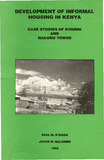| dc.contributor.author | Syagga, Paul | |
| dc.contributor.author | Malombe, Joyce | |
| dc.date.accessioned | 2016-12-19T13:38:26Z | |
| dc.date.available | 2016-12-19T13:38:26Z | |
| dc.date.issued | 1995 | |
| dc.identifier.uri | http://hdl.handle.net/11295/98017 | |
| dc.description.abstract | The urban population in Kenya has been growing fast. This demographic growth is often accompanied
by physical expansion of the centres to include what were formerly peri-urban areas into the realm of
urban administration. For example, while in 1969 there were 48 urban centres (defined as centres with
2000 inhabitants) with a total population of 1.08 million, or about 10% of the total national population,
these increased to 91 in 1979 with a total population of 2.3 million, or about 15% of the national
population. In 1989 there were 172 urban centres with a population of 4 million, or about 17.6% of the
estimated national population of 22.7 million. This rapid growth has placed a strain on the capacity of
the urban authorities to provide required basic infrastructure and urban services. Urban migration has
increased, municipal boundaries have expanded, but service standards have stagnated and per capita
urban expenditures have typically declined. | en_US |
| dc.language.iso | en | en_US |
| dc.publisher | University of Nairobi | en_US |
| dc.rights | Attribution-NonCommercial-NoDerivs 3.0 United States | * |
| dc.rights.uri | http://creativecommons.org/licenses/by-nc-nd/3.0/us/ | * |
| dc.subject | urban population, national population, | en_US |
| dc.title | Development of informal housing in Kenya case studies of Kisumu and Nakuru towns | en_US |
| dc.type | Other | en_US |



